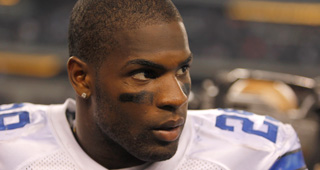Nine months ago, the New York Giants defeated the Dallas Cowboys 31-14 in the final game of the regular season. While there have been a lot of changes to both teams since, none had more of an impact on Wednesday night than a healthy DeMarco Murray. The second-year running back was the difference, rushing for 131 yards and 20 carries in the Cowboys 24-17 win.
Murray’s rookie season ended with an ankle injury he suffered in the first Dallas loss to New York, an injury that coincided exactly with the team’s late-season tailspin. The Cowboys went 5-2 when he received at least 10 carries last year and 3-6 when he did not. The NFL is a league where running backs have become increasingly devalued, but he is the rare one with the chance to become a legitimate superstar.
At 6’0 215 with 4.4 speed in the 40, Murray has almost the ideal physical dimensions of an NFL running back. More important than his physical tools, though, are his vision and feel for running the ball. Finding a crease or cut-back lane in the defense is what separates great RB’s from guys like Felix Jones, who was never able to consistently churn out positive yardage as a starter.
Take a look at the Cowboys drive chart on Wednesday: the last five were TD, TD, FG, TD, End of Game. That’s not happening without Murray constantly creating positive runs out of nothing by making guys miss in the hole and breaking through arm tackles. The Dallas offense was in a lot more manageable 2nd and 3rd down situations than they were nine months ago, preventing the Giants cadre of pass rushers (Jean Pierre-Paul, Justin Tuck, Osi Umenyiora) from teeing off on Tony Romo.
When the New York defensive ends went outside of their rush lanes, Dallas gashed them with Murray running off-tackle. It’s no coincidence Romo had only his third career game with 300 yards passing, a 75%+ completion percentage and three TD’s on Wednesday. With a dynamic rushing game to alleviate some of the offensive burden, he may be on the way to having his best season in the NFL yet.
The Cowboys have never been able to complement Romo with a great rushing game. Julius Jones, Marion Barber III and Felix Jones have all had varying degrees of success lined up behind him, as Dallas hasn’t had a 1,000 yard rusher since 2006. Before Murray was hurt in 2011, he had rushed for 897 yards on 5.5 yards per carry in only 7 starts.
That injury history was the reason Murray slipped so far in the 2011 Draft. He battled injuries in each of his four seasons at Oklahoma, the only blemish on an otherwise stellar career in Norman. As a result, he fell to the No. 71 overall pick, behind Mark Ingram, Ryan Williams, Shane Vereen, Mikel Leshoure and Daniel Thomas.
Jason Garrett and the rest of the Cowboys coaching staff will have to find ways to limit his snaps going forward. The problem is that he’s such a complete back (power, speed, vision, pass-catching and pass-blocking ability) that it’s very hard to justify taking him out of the game. And with such a slim difference between winning and losing in the NFL, having your best running back off the field for even one series can be enormous.
No position on the field has a shorter learning curve, but none has a faster decline either. There are only so many ways to run from point A to point B on a football field; it’s not a position where a surplus of experience can do a whole lot of good. The career of the average RB is less than three years long.
As a rule, they tend to peak early. In his second year in the NFL, Adrian Peterson rushed for 1,760 yards on 4.8 yards per carry, numbers he has not matched in the following three seasons. The same pattern holds true for Chris Johnson (2,006 yards on 5.6 ypc) and Ray Rice (1,339 yards on 5.3 ypc).
The more a player has been hit, the less spring he has in his steps. In that way, a RB is like a car: if you trust that the engine works, the fewer miles on the vehicle the better. By the time they got to the NFL, Ricky Williams and Ron Dayne, the two all-time leading rushers in NCAA history, had already used many of their freshest “miles”. Murray, in contrast, may benefit from absorbing fewer hits in his college days.
As long as he can stay healthy, he can paper over many of the holes that have plagued the Cowboys roster over the last few years. They were all on display against the Giants -- shaky decision-making, egregious numbers of mental errors and penalties, breakdowns on the offensive line -- but this time they didn’t cost the win. That’s what can happen when you have one of the best running backs in the NFL in your backfield.

Jonathan Tjarks wrote on the NBA for RealGM from 2011-2016 before joining The Ringer.
Follow @JonathanTjarks on Twitter.


